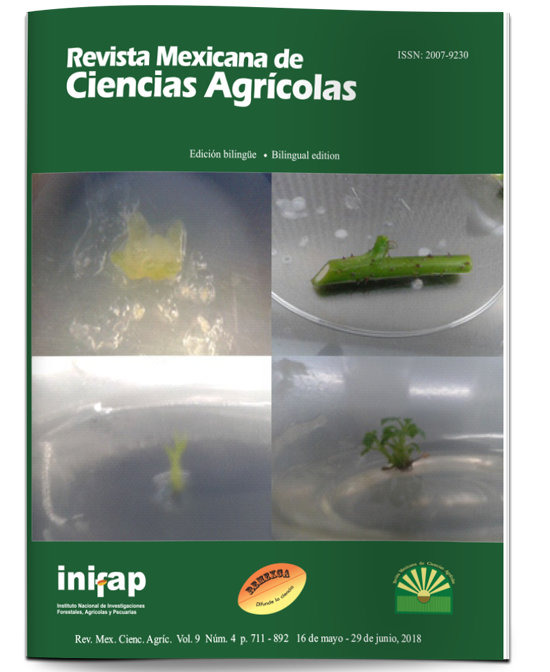Response of spinach and Spodoptera exigua to organic and mineral fertilization
DOI:
https://doi.org/10.29312/remexca.v9i4.1390Keywords:
Spinacia oleracea L., biofertilizers, compost, soldier wormAbstract
Farmers face serious phytosanitary risks and phytosanitary problems, it is generally assumed that the increase of nitrogen (N) in the plant increases the populations of pathogens. The study was carried out in the greenhouse to know the effects of the spinach (Spinacia oleracea L.) variety of Python F1, as well as the response that exists in the oviposition of females and the damage caused by larvae of Spodoptera exigua. It was fertilized with mineral fertilizer based on Steiner nutrient solution (100%, 50%) and with biofertilizers of rabbit leachate (3%) and cachaça compost (1:1 v/v). By means of the ImageJ® program the damaged area of the leaves were calculated and for the leaf area dynamics the PROC NLIN using logistic models. A statistical analysis was performed for agronomic variables, oviposition and spinach damage using Tukey test (p≤ 0.05). The results showed differences in the fresh weight of the plant (PSP) and the root (PFR), the largest leaf area was the combination treatment of cachaza compost and complete Steiner solution SN (100%), no differences were observed in the treatments at 45 and 60 days after the emergency. Regarding Spodoptera exigua, differences were found in the number of egg masses at 24 h (NMHP24), weight of the larvae (PL), number of damaged leaves (NHD) and area of the damaged leaf (AHD). The rabbit leachate can be an alternative as a biofertilizer for an organic production in spinach.
Downloads
Downloads
Published
How to Cite
Issue
Section
License
The authors who publish in Revista Mexicana de Ciencias Agrícolas accept the following conditions:
In accordance with copyright laws, Revista Mexicana de Ciencias Agrícolas recognizes and respects the authors’ moral right and ownership of property rights which will be transferred to the journal for dissemination in open access. Invariably, all the authors have to sign a letter of transfer of property rights and of originality of the article to Instituto Nacional de Investigaciones Forestales, Agrícolas y Pecuarias (INIFAP) [National Institute of Forestry, Agricultural and Livestock Research]. The author(s) must pay a fee for the reception of articles before proceeding to editorial review.
All the texts published by Revista Mexicana de Ciencias Agrícolas —with no exception— are distributed under a Creative Commons License Attribution-NonCommercial 4.0 International (CC BY-NC 4.0), which allows third parties to use the publication as long as the work’s authorship and its first publication in this journal are mentioned.
The author(s) can enter into independent and additional contractual agreements for the nonexclusive distribution of the version of the article published in Revista Mexicana de Ciencias Agrícolas (for example include it into an institutional repository or publish it in a book) as long as it is clearly and explicitly indicated that the work was published for the first time in Revista Mexicana de Ciencias Agrícolas.
For all the above, the authors shall send the Letter-transfer of Property Rights for the first publication duly filled in and signed by the author(s). This form must be sent as a PDF file to: revista_atm@yahoo.com.mx; cienciasagricola@inifap.gob.mx; remexca2017@gmail.
This work is licensed under a Creative Commons Attribution-Noncommercial 4.0 International license.



